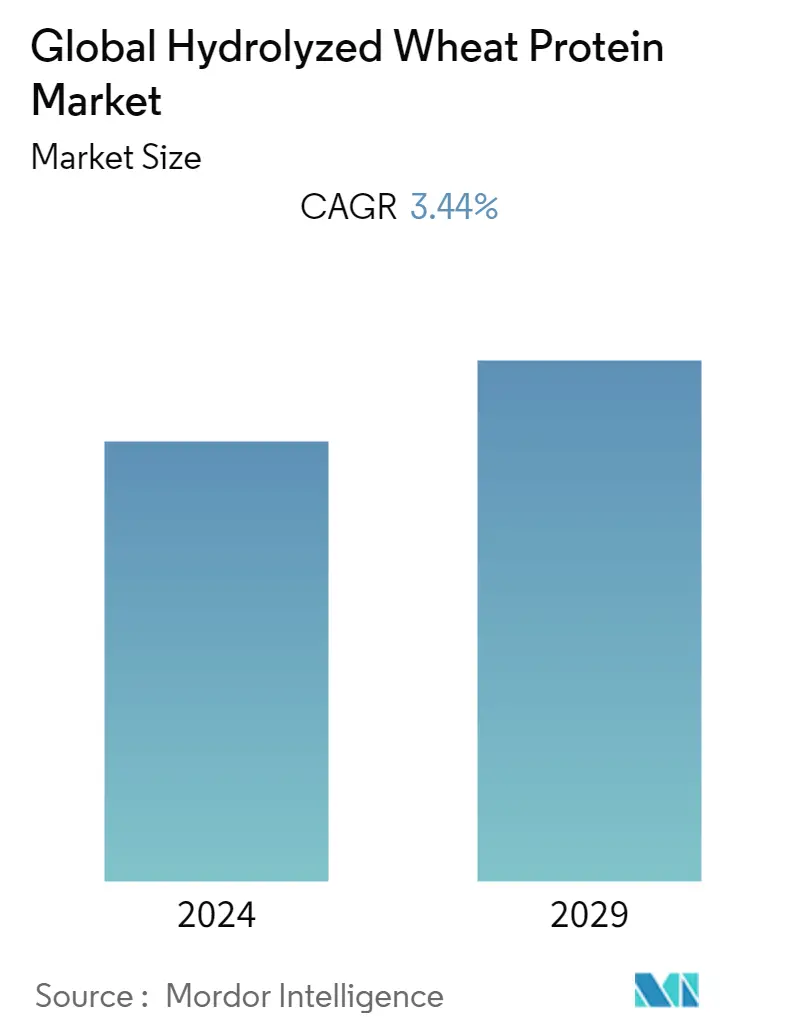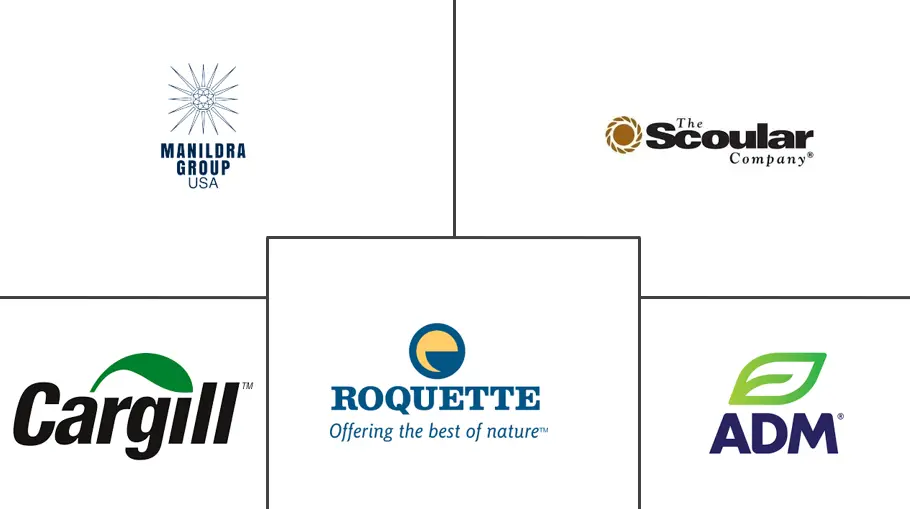Market Size of Global Hydrolyzed Wheat Protein Industry

| Study Period | 2019 - 2029 |
| Base Year For Estimation | 2023 |
| CAGR | 3.44 % |
| Fastest Growing Market | Asia Pacific |
| Largest Market | North America |
| Market Concentration | Low |
Major Players
*Disclaimer: Major Players sorted in no particular order |
Hydrolyzed Wheat Protein Market Analysis
Global Hydrolyzed Wheat Protein Market is projected to grow at a CAGR of 3.44% during the forecast period 2021-2026.
- The multi-functionality of wheat protein hydrolysates has increased its adoption across various end-user industries. The growing demand for high-protein products has further expanded the application of hydrolyzed wheat protein in various protein based formulations. Moreover, positive application outlook in nutritional RTD beverages and nutri-cosmetics is driving the hydrolyzed wheat protein market in the near future.
- The hydrolyzed wheat protein market has been largely driven by the growing demand from bakery manufacturers, the increasing popularity of plant-based foods, and hydrolyzed wheat protein being a suitable alternative for non-animal protein among vegans.
- The coronavirus pandemic has brought an exclusive change in the demand dynamics, with consumers increasingly seeking products that are nutritional and improve one's health such as gut health, enhances immunity, delivers personalized nutrition and support emotional well-being. For Instance, 18% of protein buyers in the United States purchased their first plant-based protein during the COVID-19 pandemic. In Germany, the United Kingdom and the Netherlands, 80% of consumers stated they are likely to continue eating plant-based meat alternatives beyond COVID-19.
Hydrolyzed Wheat Protein Industry Segmentation
The global hydrolyzed wheat protein market is segmented by application and geography. Based on application, the market is segmented into food & beverage, animal feed, and cosmetics & personal care. The food & beverage segment is further sub-segmented into bakery, cereals & cereal products, RTD beverages and powdered beverage mixes confectionery, and others. Furthermore, the report takes into consideration the market for hydrolyzed wheat protein in the established and emerging economies across the globe, including North America, Europe, Asia-Pacific, South America, Middle East & Africa.
| By Application | |||||||
| |||||||
| Animal Feed | |||||||
| Cosmetics & Personal Care |
| By Geography | |||||||||
| |||||||||
| |||||||||
| |||||||||
| |||||||||
|
Global Hydrolyzed Wheat Protein Market Size Summary
The hydrolyzed wheat protein market is experiencing significant growth, driven by its multi-functionality and increasing demand across various end-user industries. The rising popularity of high-protein products has expanded the application of hydrolyzed wheat protein in protein-based formulations, particularly in nutritional ready-to-drink beverages and nutri-cosmetics. The market is further bolstered by the growing demand from bakery manufacturers and the increasing inclination towards plant-based foods, where hydrolyzed wheat protein serves as a suitable alternative for non-animal protein, especially among vegans. The COVID-19 pandemic has shifted consumer preferences towards products that enhance health, immunity, and well-being, contributing to the market's expansion. The plant protein market, in particular, is benefiting from the trend towards vegan diets, functional efficiency, and cost competitiveness, with hydrolyzed wheat protein playing a crucial role in the development of ready-to-eat products and dairy-free options.
The North American region holds the largest market share for hydrolyzed wheat protein, followed by Europe and Asia-Pacific, with a growing demand for plant-based food and beverages driven by consumer awareness of their benefits. The market is highly competitive, with major global companies like Archer Daniels Midland, Cargill Incorporated, Manildra Group USA, Roquette Frères, and The Scoular Company actively participating. These companies are expanding their presence through strategic agreements and partnerships, targeting countries with large consumer bases to cater to evolving consumer preferences. The favorable government policies aimed at reducing diseases linked to meat consumption are also expected to support the growth of the plant protein market, further driving the demand for hydrolyzed wheat protein.
Global Hydrolyzed Wheat Protein Market Size - Table of Contents
-
1. MARKET DYNAMICS
-
1.1 Market Drivers
-
1.2 Market Restraints
-
1.3 Porter's Five Forces Analysis
-
1.3.1 Threat of New Entrants
-
1.3.2 Bargaining Power of Buyers/Consumers
-
1.3.3 Bargaining Power of Suppliers
-
1.3.4 Threat of Substitute Products
-
1.3.5 Intensity of Competitive Rivalry
-
-
-
2. MARKET SEGMENTATION
-
2.1 By Application
-
2.1.1 Food & Beverage
-
2.1.1.1 Bakery
-
2.1.1.2 Cereals & Cereal Products
-
2.1.1.3 RTD Beverages and Powdered Beverage Mixes
-
2.1.1.4 Confectionery
-
2.1.1.5 Others
-
-
2.1.2 Animal Feed
-
2.1.3 Cosmetics & Personal Care
-
-
2.2 By Geography
-
2.2.1 North America
-
2.2.1.1 United States
-
2.2.1.2 Canada
-
2.2.1.3 Mexico
-
2.2.1.4 Rest of North America
-
-
2.2.2 Europe
-
2.2.2.1 Spain
-
2.2.2.2 United Kingdom
-
2.2.2.3 Germany
-
2.2.2.4 France
-
2.2.2.5 Italy
-
2.2.2.6 Russia
-
2.2.2.7 Rest of Europe
-
-
2.2.3 Asia Pacific
-
2.2.3.1 China
-
2.2.3.2 Japan
-
2.2.3.3 India
-
2.2.3.4 Australia
-
2.2.3.5 Rest of Asia-Pacific
-
-
2.2.4 South America
-
2.2.4.1 Brazil
-
2.2.4.2 Argentina
-
2.2.4.3 Rest of South America
-
-
2.2.5 Middle East and Africa
-
2.2.5.1 South Africa
-
2.2.5.2 Saudi Arabia
-
2.2.5.3 Rest of Middle East and Africa
-
-
-
Global Hydrolyzed Wheat Protein Market Size FAQs
What is the current Global Hydrolyzed Wheat Protein Market size?
The Global Hydrolyzed Wheat Protein Market is projected to register a CAGR of 3.44% during the forecast period (2024-2029)
Who are the key players in Global Hydrolyzed Wheat Protein Market?
Cargill, Incorporated, MGP, Manildra Group USA, Roquette Frères and The Scoular Company are the major companies operating in the Global Hydrolyzed Wheat Protein Market.

